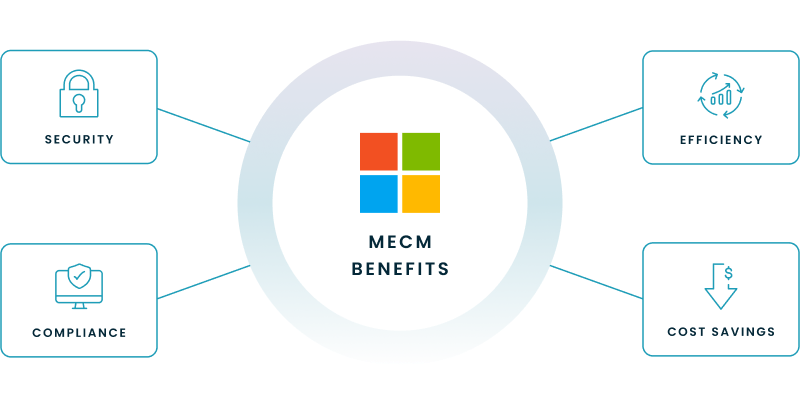Microsoft Endpoint Configuration Manager
This resource defines Microsoft Endpoint Configuration Manager, covering its core features, use cases, and role in modern enterprise IT.
NerdioCon 2026: Don’t miss out! Lock in your spot early and save — this is the IT event of the year.
Register Now
This resource defines Microsoft Endpoint Configuration Manager, covering its core features, use cases, and role in modern enterprise IT.
Amol Dalvi | June 26, 2025
Table of Contents
Microsoft Endpoint Configuration Manager (MECM), formerly SCCM, is an on-premises platform for managing large fleets of servers, desktops, and laptops. It gives IT centralized control to deploy software, enforce security policies, and manage device health at scale.
Its core purpose is to automate IT operations, ensure consistency across all computers, and strengthen an organization's security posture, making it a foundational tool for enterprise IT management.
In any large organization, the hundreds or thousands of computers used by employees are known as "endpoints." Without a centralized way to manage them, your organization is exposed to significant risk and inefficiency. Unmanaged endpoints can quickly lead to security breaches, software inconsistencies, and a heavy, reactive workload for your IT team.
A powerful endpoint management solution addresses these challenges directly, forming the foundation of a secure and efficient end user computing environment, which includes all the systems and services employees rely on to perform their work.

The key benefits include:
Configuration Manager is a comprehensive suite of tools, but its functionality can be broken down into a few core areas. Each one provides granular control over a different aspect of the device lifecycle.
Configuration Manager excels at deploying Windows operating systems at scale. Using features like task sequences and OS imaging, your IT team can execute "bare-metal" installations on new hardware or perform in-place upgrades on existing machines. For your business, this means a new employee can receive a laptop that is fully configured, secure, and ready for work in a fraction of the time it would take to set it up manually, ensuring they are productive from day one.
One of the most critical functions of Configuration Manager is keeping your systems patched and secure. It integrates deeply with Windows Server Update Services (WSUS) to give your IT team precise control over which updates get deployed to which devices and when. This ensures your organization is automatically protected from the latest known vulnerabilities and allows you to easily generate reports for security audits, proving all systems are compliant.
Configuration Manager allows you to manage the entire application lifecycle. Through the "Software Center," you can create a self-service portal—like a private app store—where users can install pre-approved software themselves. For mandatory applications, your IT team can push installations to specific user groups or devices, set complex installation rules, and ensure that every user has the correct software tools for their role while preventing the use of unauthorized or insecure programs.
You can't manage what you can't see. Configuration Manager performs deep hardware and software inventory scans on every managed device. This data provides a complete and accurate picture of your IT environment, helping you answer critical business questions like, "Which computers are due for a hardware refresh?" or, "Are we paying for more software licenses than we are actually using?"
Beyond just deploying patches, Configuration Manager helps you enforce a consistent security baseline. Your team can set and monitor thousands of configuration settings, manage Windows Defender Antivirus policies, and control Windows Firewall rules from a central console. This ensures every company-owned device adheres to your corporate security standards, hardening your defenses against threats.
One of the most common points of confusion is understanding the difference between Configuration Manager and Microsoft Intune. While both are used for endpoint management, they were designed for different purposes and excel in different scenarios. The distinction is particularly relevant for modern IT strategies that include Desktop as a Service (DaaS), a model where cloud providers deliver virtual desktops to any device, which relies heavily on cloud-native management.
| Aspect | Microsoft Endpoint Configuration Manager (MECM/SCCM) | Microsoft Intune |
|---|---|---|
| Primary Architecture | On-premises (requires servers) | Cloud-native (SaaS) |
| Primary Use Case | Managing corporate-owned, domain-joined PCs and servers inside the corporate network. | Managing mobile devices (iOS, Android) and PCs anywhere, including personal devices (BYOD). |
| Management Style | Deep, granular control over every aspect of the OS. Agent-based. | Modern, policy-based management focused on security and data access. Agentless (uses built-in OS APIs). |
| Key Strengths | Complex OS deployment, detailed inventory, server patching. | Zero-touch provisioning (Autopilot), mobile application management (MAM), conditional access policies. |
Co-management is the bridge that connects Configuration Manager to Intune, allowing you to manage a Windows 10/11 device with both tools simultaneously. This approach allows you to leverage your existing investment and processes in Configuration Manager for heavy-duty tasks like OS deployment while using Intune's modern, cloud-powered capabilities for things like mobile security policies and managing Azure VDI environments, which deliver secure virtual desktops hosted in the cloud. It offers a practical path to gradually transition workloads to the cloud without disrupting your current operations.
While Microsoft's strategic direction is "cloud-first" with Intune, Configuration Manager is not being replaced. It continues to be an essential tool for large enterprises with significant on-premises investments, especially for managing servers, data centers, and complex application deployments where its granular control is indispensable.
In the modern, cloud-focused landscape, Configuration Manager remains the best choice for specific, critical use cases:
These use cases often stand in contrast to modern management scenarios that leverage VDI (Virtual Desktop Infrastructure), which centralizes a user's desktop environment on a server and streams it to them on any device, and is typically managed with cloud-native tools.
As your organization adopts platforms like Azure Virtual Desktop (AVD) and Windows 365, which provide users with a secure, personalized Cloud PC experience accessible from anywhere, your endpoint management strategy must evolve. While Configuration Manager and Intune are powerful tools for physical devices, managing virtual desktop environments at scale presents a new set of challenges related to image management, session host automation, and cost optimization.
Nerdio Manager for Enterprise is an automation platform that complements your existing management tools. It sits on top of AVD and Windows 365 to automate the deployment, management, and optimization of your virtual desktop environment in Microsoft Azure. Nerdio helps bridge the gap between your traditionally managed physical endpoints and your new cloud-based virtual endpoints, ensuring a unified, efficient, and cost-effective strategy for your entire device ecosystem.
See this demo to learn how Nerdio gives you the tools to manage the Microsoft Cloud from AVD and Windows 365 to Microsoft 365 and Intune.
See how you can optimize processes, improve security, increase reliability, and save up to 70% on Microsoft Azure costs.
No, they are not exactly the same. Microsoft Endpoint Manager was the name for the suite of management solutions that included both Microsoft Intune and Microsoft Endpoint Configuration Manager (SCCM/MECM). While SCCM was a component of the broader Microsoft Endpoint Manager brand, the two terms referred to the on-premises product and the larger cloud-integrated family, respectively.
The MECM client is typically installed automatically on devices connected to the corporate network through a "client push installation" from the primary site server. Alternatively, it can be included as part of a standard operating system image, so it is present on all new computers from the start.
MECM's primary differentiators are its deep, granular control over on-premises Windows environments and its powerful capabilities for complex operating system deployment and software patching. Its tight integration with the broader Microsoft server ecosystem, like Active Directory and WSUS, also sets it apart from many third-party tools.
The product was known as System Center Configuration Manager (SCCM) for over a decade, and the name became deeply ingrained in the IT community. Although Microsoft officially rebranded it, many IT professionals still use the old name out of habit, and it frequently appears in older documentation and third-party articles.
SCCM primarily manages Windows client operating systems (like Windows 10 and 11) and Windows Server operating systems. It also has some limited, built-in capabilities for managing macOS, but full support for other platforms like iOS and Android is handled by Microsoft Intune, which provides a unified, cloud-native management platform for all endpoints regardless of location or operating system.
Troubleshooting typically starts in the Configuration Manager console by reviewing the deployment status for success or error codes. For more detail, you would examine the log files on the client computer, such as AppEnforce.log and CAS.log located in the C:\Windows\CCM\Logs directory, which provide specific information on why an installation failed.



Software product executive and Head of Product at Nerdio, with 15+ years leading engineering teams and 9+ years growing a successful software startup to 20+ employees. A 3x startup founder and angel investor, with deep expertise in Microsoft full stack development, cloud, and SaaS. Patent holder, Certified Scrum Master, and agile product leader.